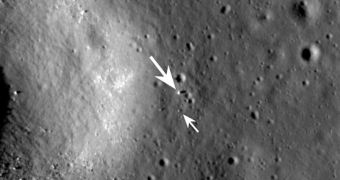Officials at the American space agency have just released a series of new images showing the Chinese National Space Administration's (CNSA) Chang'e-3 lunar lander and its six-wheeled Yutu rover. The images were collected by the powerful cameras on the NASA Lunar Reconnaissance Orbiter (LRO).
The Chinese lander made a soft landing on the Moon, the first one since 1976, on December 14, 2013, after a five-day descent through the lunar atmosphere. Just seven hours after touching down, it released the Yutu, or Jade Rabbit, rover, which immediately began taking pictures of the surface.
Chang'e-3 was deployed in Mare Imbrium, one of the most famous and beautiful locations on the Moon. It is the third spacecraft developed by CNSA to survey Earth's natural satellite, and the first to actually touch down on its surface. Two more missions will land on the Moon by 2017, CNSA announced.
According to the LRO images, the spacecraft landed just 40 meters (131 feet) away from a 450-meter (1,475-foot) wide impact crate in Mare Imbrium. As soon as Chang'e-3 touched down, CNSA officials said that the intended landing spot has been achieved with a great deal of precision.
The last mission to make a controlled, soft landing on the lunar surface was the Luna 24 sample-return mission developed by the Soviet Union. The last time NASA put a spacecraft on the Moon in this manner was in 1972, when the Apollo 17 manned mission touched down, Space reports.
When Chang'e touched down, the LRO was not in a good position to observe the event. However, as soon as it became possible, NASA experts aimed its LRO Camera (LROC) instrument at the site, and began taking picture. The principal investigator for this instrument is expert Mark Robinson, who holds an appointment with the School of Earth and Space Exploration at the Arizona State University (ASU).
LRO snapped its images of Mare Imbrium on December 24, 2013, just 10 days after Chang'e-3 landed. The Narrow Angle Camera (NAC) on LROC snapped a total of 6 image pair during 19 orbits over this location, an effort which took around 36 hours to complete.
At the time, the NASA orbiter was around 150 kilometers (93 miles) above the Chinese spacecraft. The highest-resolution image of Chang'e-3 and Yutu was collected on Christmas Day, NASA experts say.
The reason why both spacecraft are clearly visible despite their small sizes is that they were photographed at sunset, meaning that they cast a very long shadow on the surrounding landscape. At the same time, their solar panels are very effective at reflecting light upwards.
“We plan on imaging the site each month. Let's hope Yutu lasts several years. Perhaps it can break the Lunokhod 2 long-distance roving record?” Robinson concludes.

 14 DAY TRIAL //
14 DAY TRIAL //